Numerical Simulation of Electromagnetic–Thermal–Fluid Coupling for the Deformation Behavior of Titanium–Aluminum Alloy under Electromagnetic Levitation
Abstract
:1. Introduction
2. Physical and Numerical Models
2.1. Physical Model
- (1)
- In the lower part, a specimen with a moderate mass made of a Ti–Al alloy is levitated by the Lorentz force. It is then quickly heated up and melted due to Joule heat.
- (2)
- The upper part is designed to prevent oscillation of the specimen.
2.2. Mathematical Model
2.2.1. Assumptions
- (1)
- Since the numerical model is a two-dimensional axisymmetric model, only the oscillations occurring in the vertical direction are considered;
- (2)
- In the fluid model, both the molten droplet and the gas are set as incompressible fluids, and the pressure generated by the gas flow on the surface of the suspended droplet is ignored;
- (3)
- The mass of the molten droplet is constant without considering the volatilization that occurs when the temperature of the droplet is above the liquid phase line.
2.2.2. Mathematical Equations
2.2.3. Initial and Boundary Conditions
- (1)
- The boundary condition for fluid flow at the droplet surface is given by the following:where ξ is the local average curvature of the surface.
- (2)
- Radiation of heat from the surface to the environment is as follows:where T is the sample temperature, Tamb is the ambient temperature, and εr and σr are the emissivity and Boltzmann constant, respectively.
- (3)
- Initial conditions for the thermal and flow fields include the following: Tint = Tamb = 298 K, u = 0, p0 = 101 kPa.
2.3. Model Parameters
3. Results and Discussion
3.1. Simulation of Electromagnetic Levitation Multiphysics Field
3.1.1. Simulation Validation
3.1.2. Simulation of Electromagnetic Field
3.1.3. Simulation of Fluid Field
3.1.4. Simulation of Thermal Field
3.2. Simulation of the Oscillation Process of Molten Droplets
3.3. Simulation of the Deformation Process of Molten Droplets
4. Conclusions
- (1)
- The maximum velocity zones of the electromagnetically levitated droplets are located on the left and right sides near the droplet surface. Then, the number of vortices also rises from four to six with the current increase. The maximum temperature is observed at the bottom of the molten droplet, while the temperature near the center is relatively lower. The application of electromagnetic stirring results in a more uniform temperature distribution within the molten droplet, with a temperature difference of approximately 2 K.
- (2)
- The titanium–aluminum alloy molten droplet is damped and oscillates from its initial position due to the combined effects of gravity and the Lorentz force. The amplitude of the oscillation increases with the current, but when the current increases from 462 A to 546 A, the levitation time to reach a steady state decreases gradually, from 4.34 s to 2.86 s.
- (3)
- The integrated force field exerts a linear influence on the longitudinal diameter of the titanium–aluminum alloy molten droplet, which increases with the current. In contrast, the transverse diameter undergoes a gradual flattening. At the onset of oscillation, the molten droplet exhibits greater deformation, before reaching a stabilization period where its shape remains unchanged and assumes a “near-rhombus” configuration.
Author Contributions
Funding
Institutional Review Board Statement
Informed Consent Statement
Data Availability Statement
Conflicts of Interest
References
- Genc, O.; Unal, R. Development of gamma titanium aluminide (γ-TiAl) alloys: A review. J. Alloys Compd. 2022, 929, 167262. [Google Scholar] [CrossRef]
- Lim, H.P.; Liew, W.Y.H.; Melvin, G.J.H.; Jiang, Z.-T. A short review on the phase structures, oxidation kinetics, and mechanical properties of complex Ti-Al alloys. Materials 2021, 14, 1677. [Google Scholar] [CrossRef] [PubMed]
- Kastenhuber, M.; Rashkova, B.; Clemens, H.; Mayer, S. Enhancement of creep properties and microstructural stability of intermetallic β-solidifying γ-TiAl based alloys. Intermetallics 2015, 63, 19–26. [Google Scholar] [CrossRef]
- Gupta, R.K.; Pant, B.; Sinha, P.P. Theory and practice of γ+ α2 Ti aluminide: A review. Trans. Indian Inst. Met. 2014, 67, 143–165. [Google Scholar] [CrossRef]
- Ostrovskaya, O.; Badini, C.; Baudana, G.; Padovano, E.; Biamino, S. Thermogravimetric investigation on oxidation kinetics of complex Ti-Al alloys. Intermetallics 2018, 93, 244–250. [Google Scholar] [CrossRef]
- Reiplinger, B.; Plevachuk, Y.; Brillo, J. Surface tension of liquid Ti, V and their binary alloys measured by electromagnetic levitation. J. Mater. Sci. 2022, 57, 21828–21840. [Google Scholar] [CrossRef]
- Egry, I.; Diefenbach, A.; Dreier, W.; Piller, J. Containerless processing in space—Thermophysical property measurements using electromagnetic levitation. Int. J. Thermophys. 2001, 22, 569–578. [Google Scholar] [CrossRef]
- Wu, P.; Yang, Y.; Barati, M.; McLean, A. Electromagnetic levitation of silicon and silicon-iron alloy droplets. High Temp. Mater. Process. 2014, 33, 477–483. [Google Scholar] [CrossRef]
- Brillo, J.; Lohofer, G.; Hohagen, F.S.; Schneider, S.; Egry, I. Thermophysical property measurements of liquid metals by electromagnetic levitation. Int. J. Mater. Prod. Technol. 2006, 26, 247–273. [Google Scholar] [CrossRef]
- Bracker, G.; Schneider, S.; Matson, D.; Hyers, R. Dynamic nucleation in sub-critically undercooled melts during electromagnetic levitation. Materialia 2022, 26, 101623. [Google Scholar] [CrossRef]
- Reinartz, M.; Kolbe, M.; Herlach, D.M.; Rettenmayr, M.; Toropova, L.V.; Alexandrov, D.V.; Galenko, P.K. Study on anomalous rapid solidification of Al-35 at% Ni in microgravity. JOM 2022, 74, 2420–2427. [Google Scholar] [CrossRef]
- Watanabe, M.; Takahashi, Y.; Imaizumi, S.; Zhao, Y.; Adachi, M.; Ohtsuka, M.; Chiba, A.; Koizumi, Y.; Fukuyama, H. Thermophysical properties of liquid Co–Cr–Mo alloys measured by electromagnetic levitation in a static magnetic field. Thermochim. Acta 2022, 708, 179119. [Google Scholar] [CrossRef]
- Liu, Y.; Zhang, G.F.; Qi, X.; Shi, Z.; Yan, P.; Jiang, Q. Research Progress on Application and Numerical Simulation of Electromagnetic Levitation Melting Metal Alloy. Mater. Rep. 2022, 36, 20080265-8. [Google Scholar]
- Matson, D.M.; Battezzati, L.; Galenko, P.K.; Gandin, C.-A.; Gangopadhyay, A.K.; Henein, H.; Kelton, K.F.; Kolbe, M.; Valloton, J.; Vogel, S.C.; et al. Electromagnetic levitation containerless processing of metallic materials in microgravity: Rapid solidification. NPJ Microgravity 2023, 9, 65. [Google Scholar] [CrossRef]
- Kermanpur, A.; Jafari, M.; Vaghayenegar, M. Electromagnetic-thermal coupled simulation of levitation melting of metals. J. Mater. Process. Technol. 2011, 211, 222–229. [Google Scholar] [CrossRef]
- Asakuma, Y.; Sakai, Y.; Hahn, S.H.; Tsukada, T.; Hozawa, M.; Matsumoto, T.; Fujii, H.; Nogi, K.; Imaishi, N. Equilibrium shape of a molten silicon drop in an electromagnetic levitator in microgravity environment. Metall. Mater. Trans. B 2000, 31, 327–329. [Google Scholar] [CrossRef]
- Liang, C.; Wang, H.P.; Zhang, P.C.; Wei, B. Liquid dripping dynamics and levitation stability control of molten Ti–Al–Nb alloy within electromagnetic fields. Phys. Fluids 2022, 34, 055113. [Google Scholar] [CrossRef]
- Braess, H.; Wriggers, P. Arbitrary Lagrangian Eulerian finite element analysis of free surface flow. Comput. Methods Appl. Mech. Eng. 2000, 190, 95–109. [Google Scholar] [CrossRef]
- Saadat, M.H.; Karlin, I.V. Arbitrary Lagrangian–Eulerian formulation of lattice Boltzmann model for compressible flows on unstructured moving meshes. Phys. Fluids 2020, 32, 046105. [Google Scholar] [CrossRef]
- Feng, L.; Shi, W.Y. The influence of eddy effect of coils on flow and temperature fields of molten droplet in electromagnetic levitation device. Metall. Mater. Trans. B 2015, 46, 1895–1901. [Google Scholar] [CrossRef]
- Yan, P.; Zhang, G.; Yang, Y.; Mclean, A. Numerical investigation of the position and asymmetric deformation of a molten droplet in the electromagnetic levitation system. Metall. Mater. Trans. B 2020, 51, 247–257. [Google Scholar] [CrossRef]
- Wunderlich, R.K.; Hecht, U.; Hediger, F.; Fecht, H. Surface Tension, Viscosity, and Selected Thermophysical Properties of Ti48Al48Nb2Cr2, Ti46Al46Nb8, and Ti46Al46Ta8 from Microgravity Experiments. Adv. Eng. Mater. 2018, 20, 1800346. [Google Scholar] [CrossRef]
- Brillo, J.; Wessing, J.J. Density, Molar Volume, and Surface Tension of Liquid Al-Ti. Metall. Mater. Trans. A 2017, 48, 868–882. [Google Scholar]
- Yan, P.; Zhang, G.; Yang, Y.; Mclean, A. Numerical simulation of Marangoni effect on the deformation behavior and convection of electromagnetic levitated silicon droplets under static magnetic fields. Int. J. Heat Mass Transf. 2020, 163, 120489. [Google Scholar] [CrossRef]
- Adachi, M.; Aoyagi, T.; Mizuno, A.; Watanabe, M.; Kobatake, H.; Fukuyama, H. Precise density measurements for electromagnetically levitated liquid combined with surface oscillation analysis. Int. J. Thermophys. 2008, 29, 2006–2014. [Google Scholar] [CrossRef]
- Wang, S.; Li, H.; Yuan, D.; Wang, S.; Wang, S.; Zhu, T.; Zhu, J. Oscillations and size control of titanium droplet for electromagnetic levitation melting. IEEE Trans. Magn. 2017, 54, 1–4. [Google Scholar] [CrossRef]
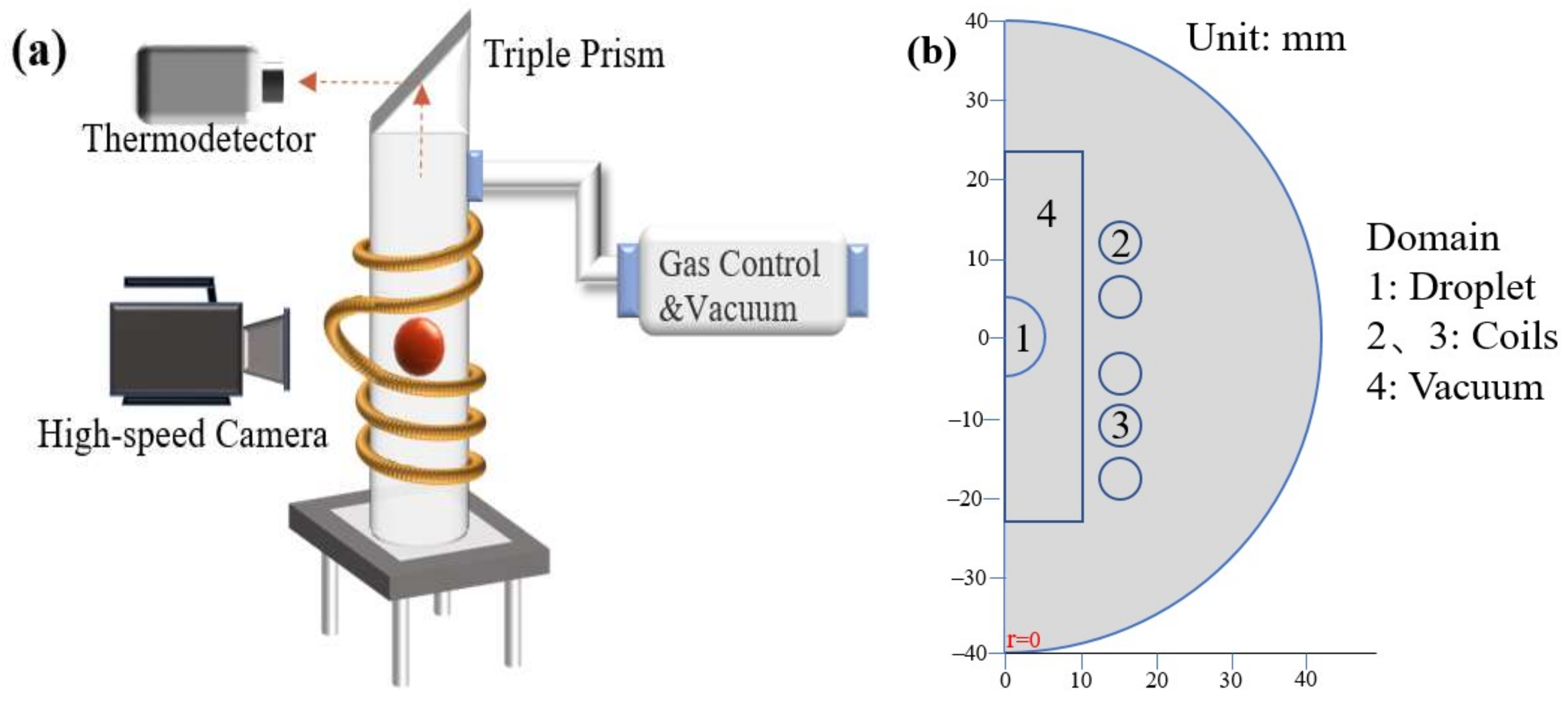

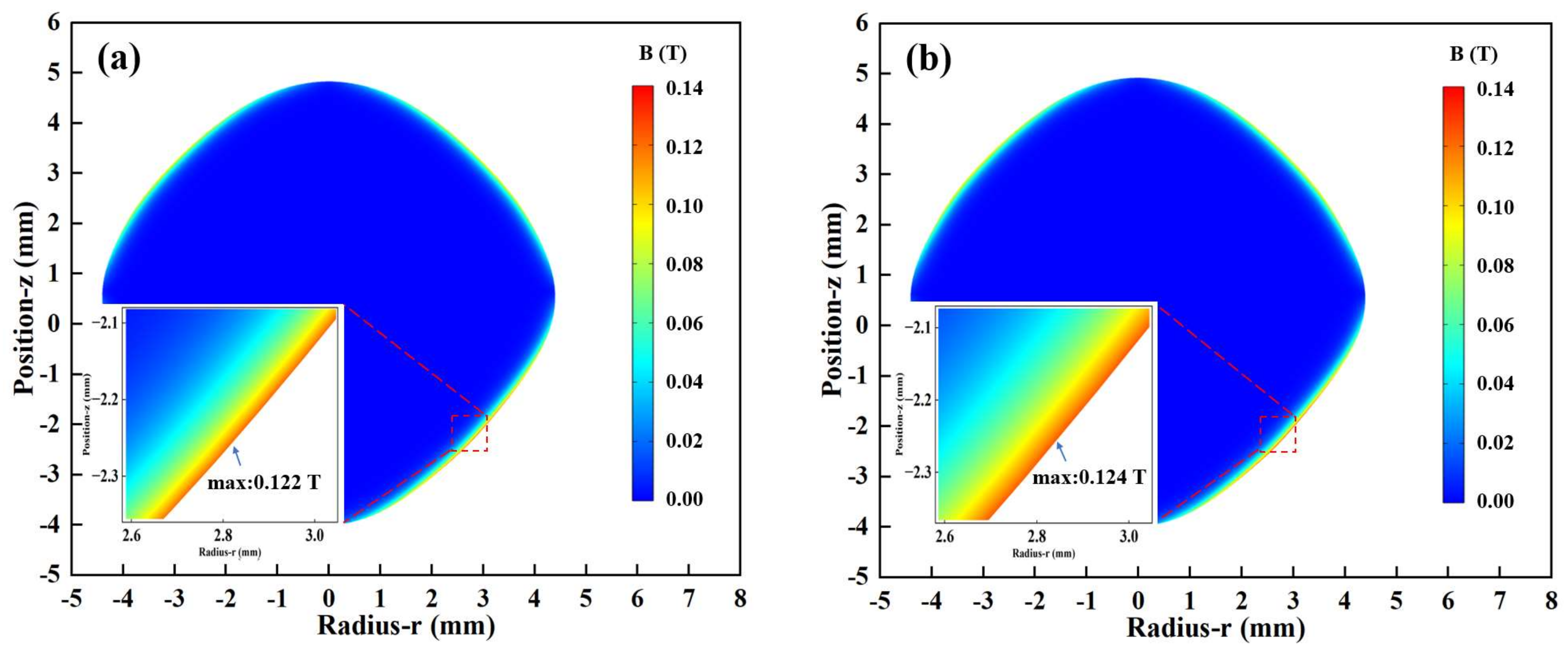

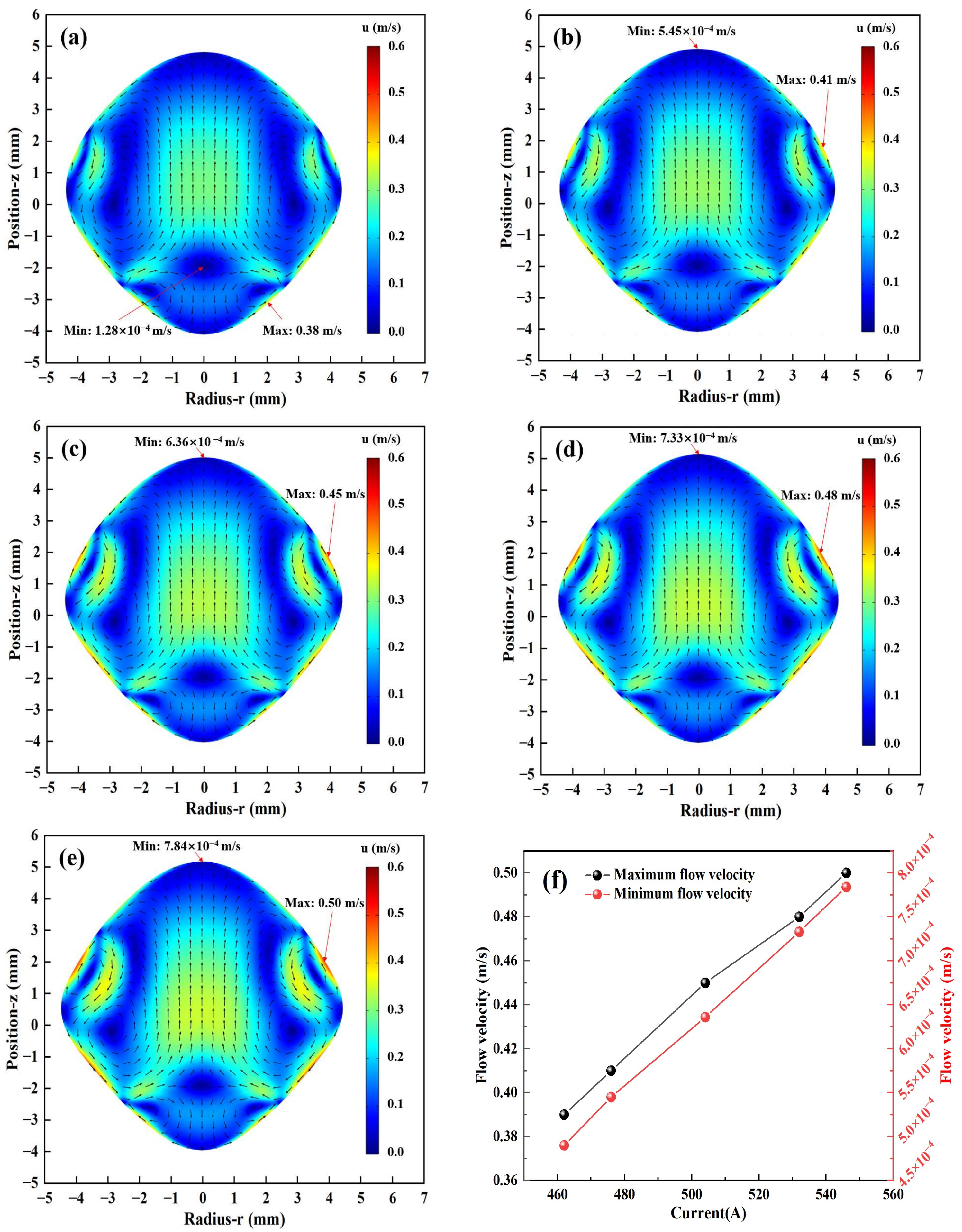
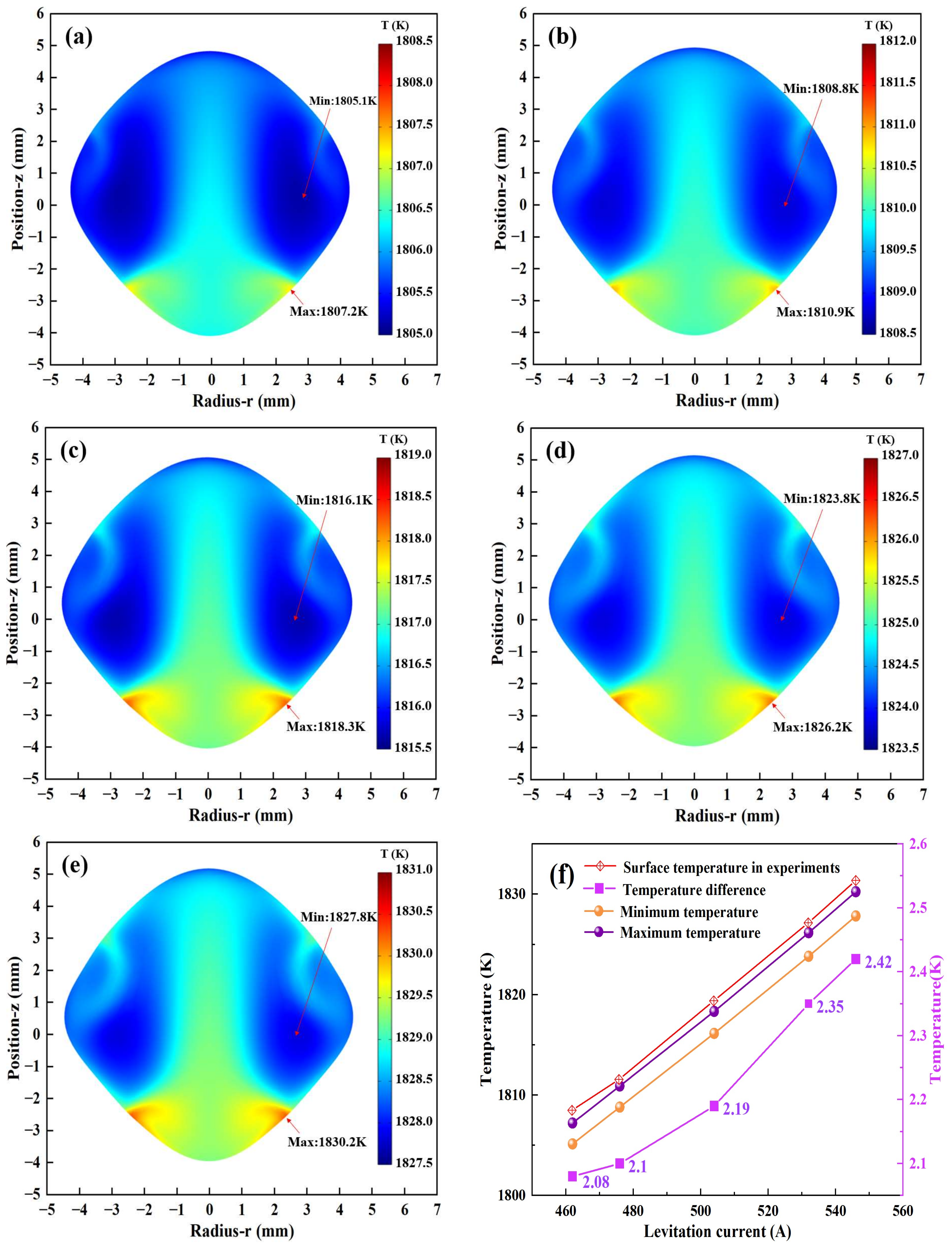

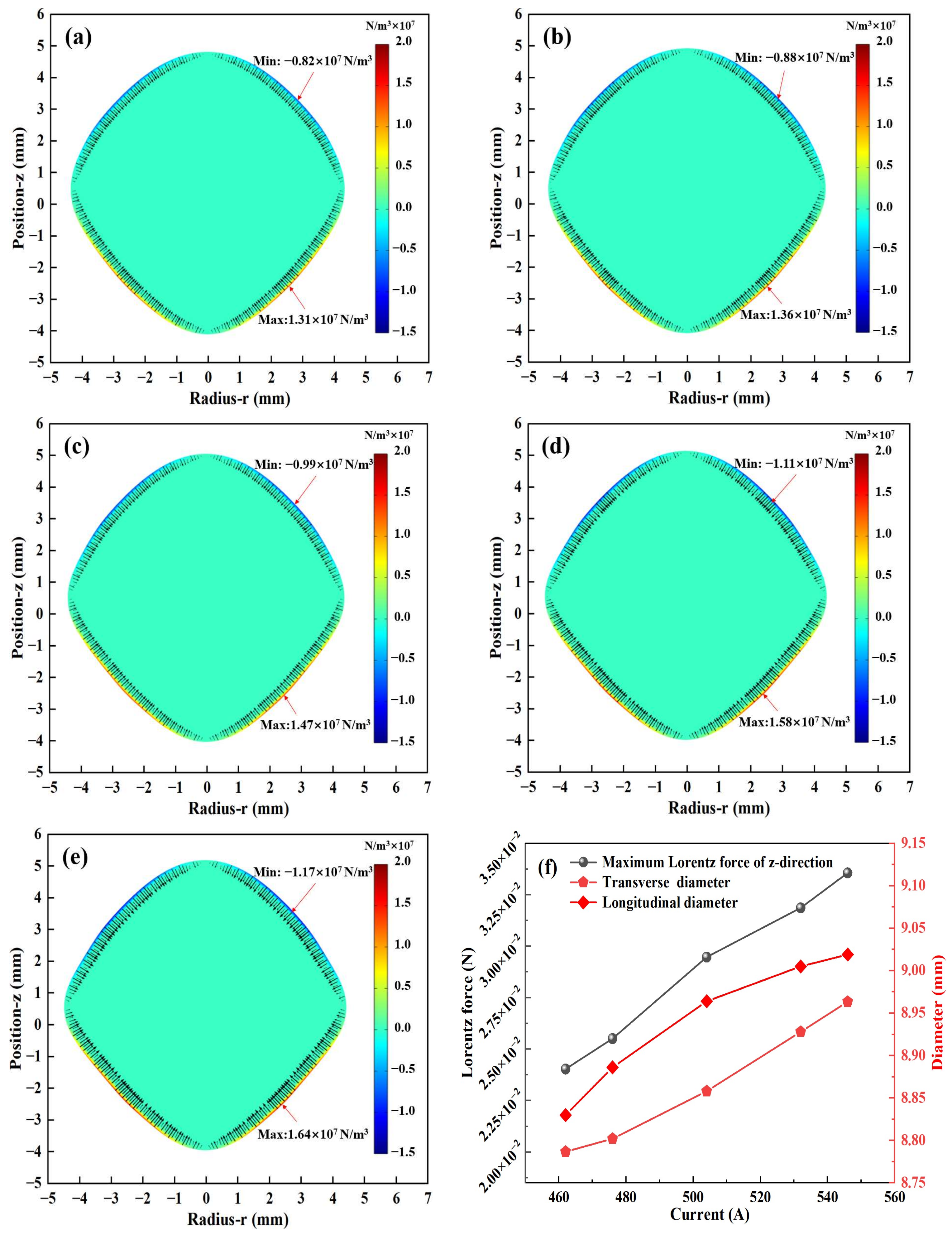
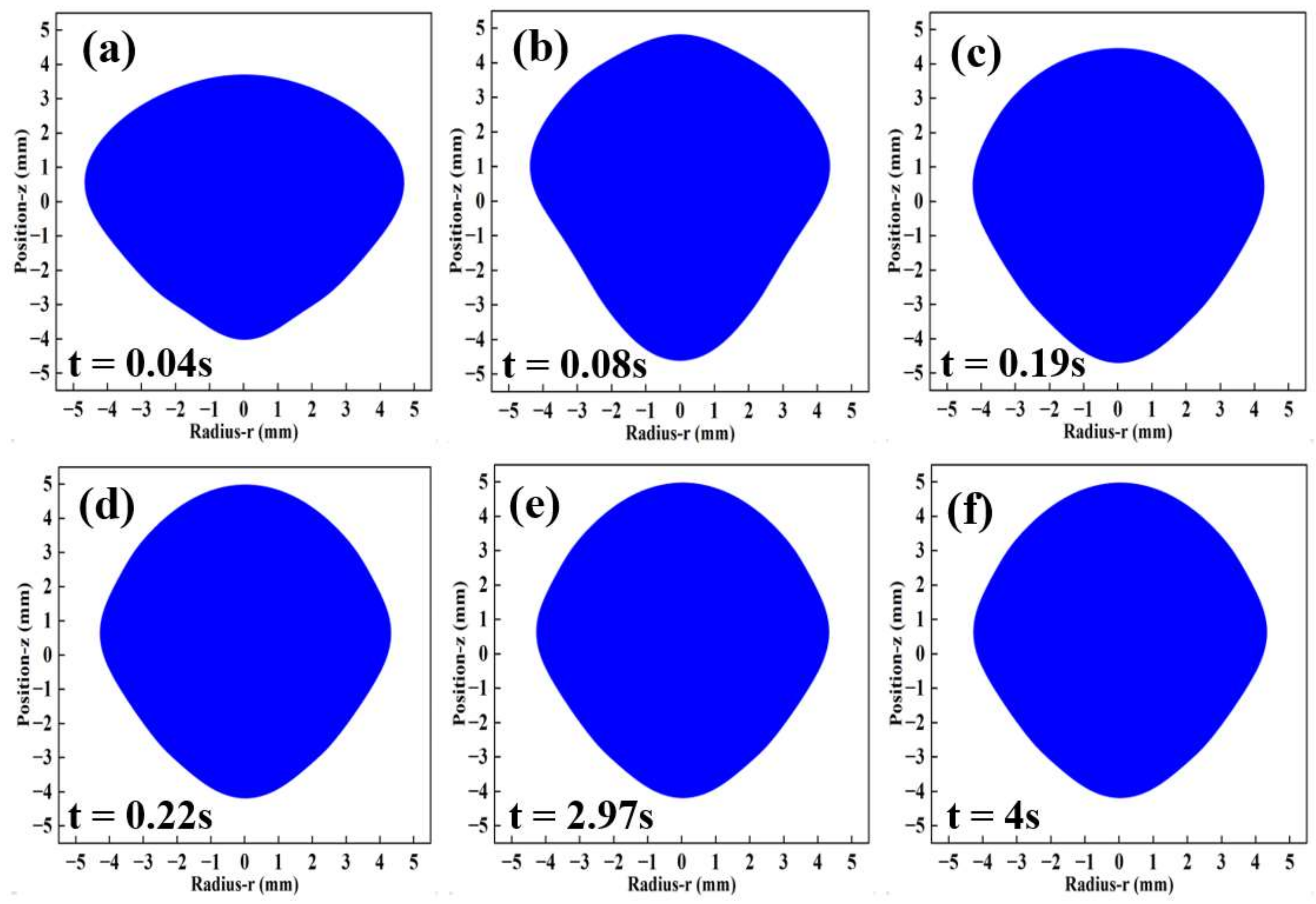

| Physical Properties of Titanium–Aluminum Alloy | |
|---|---|
| Melting point [K] | 1773 |
| Conductivity [S/m] | 1.3 × 107 |
| Relative permeability | 5 |
| Density [Kg/m3] | (−0.0005 × T + 4.2254) × 1000 |
| Dynamic viscosity [Pa·s] | (0.06071 − (6.89 × 10−5) × T + (2.695 × 10−8) × T2 − (3.583 × 10−12) × T3 |
Disclaimer/Publisher’s Note: The statements, opinions and data contained in all publications are solely those of the individual author(s) and contributor(s) and not of MDPI and/or the editor(s). MDPI and/or the editor(s) disclaim responsibility for any injury to people or property resulting from any ideas, methods, instructions or products referred to in the content. |
© 2024 by the authors. Licensee MDPI, Basel, Switzerland. This article is an open access article distributed under the terms and conditions of the Creative Commons Attribution (CC BY) license (https://creativecommons.org/licenses/by/4.0/).
Share and Cite
Wang, X.; Zhang, G.; Yan, P.; Pang, X.; Xiao, Z. Numerical Simulation of Electromagnetic–Thermal–Fluid Coupling for the Deformation Behavior of Titanium–Aluminum Alloy under Electromagnetic Levitation. Materials 2024, 17, 3338. https://doi.org/10.3390/ma17133338
Wang X, Zhang G, Yan P, Pang X, Xiao Z. Numerical Simulation of Electromagnetic–Thermal–Fluid Coupling for the Deformation Behavior of Titanium–Aluminum Alloy under Electromagnetic Levitation. Materials. 2024; 17(13):3338. https://doi.org/10.3390/ma17133338
Chicago/Turabian StyleWang, Xiaoliang, Guifang Zhang, Peng Yan, Xinchen Pang, and Zhixiang Xiao. 2024. "Numerical Simulation of Electromagnetic–Thermal–Fluid Coupling for the Deformation Behavior of Titanium–Aluminum Alloy under Electromagnetic Levitation" Materials 17, no. 13: 3338. https://doi.org/10.3390/ma17133338





